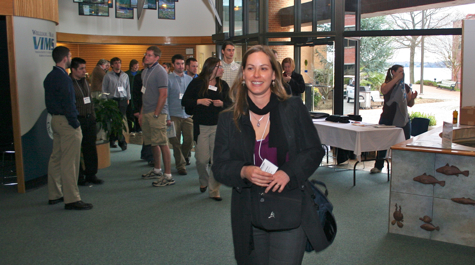VIMS hosts 25th annual fisheries meeting
The Virginia Institute of Marine Science hosted the 25th Annual Meeting of the American Fisheries Society’s Tidewater Chapter from March 10-12 on the VIMS campus in Gloucester Point.
 The three-day meeting, organized by VIMS fisheries scientist
Leonard Machut, brought together nearly 100 researchers from Virginia, Maryland,
and North Carolina to share findings from their studies of fish and fisheries.
Their research ranges from the headwater streams of the Appalachians to Chesapeake Bay
and the open waters of the Atlantic Ocean.
The three-day meeting, organized by VIMS fisheries scientist
Leonard Machut, brought together nearly 100 researchers from Virginia, Maryland,
and North Carolina to share findings from their studies of fish and fisheries.
Their research ranges from the headwater streams of the Appalachians to Chesapeake Bay
and the open waters of the Atlantic Ocean.
Chancellor professor John Graves, chair of the Fisheries Science Department at VIMS, says the meeting “provides an important venue for fishery scientists from across the mid-Atlantic to discuss research findings and share new ideas.” He says the event also gave VIMS graduate students valuable experience in organizing and hosting a scientific meeting, an important career skill as the importance of data sharing and interdisciplinary studies continues to grow.
Machut, current president of the AFS Tidewater Chapter, notes that the meeting attracted individuals from 16 different academic institutions, state and federal agencies, and non-governmental groups.
VIMS presentations
A number of faculty, staff, and students from VIMS presented posters or talks describing their research.
- Post-doctoral associate Filipe Ribeiro described a collaborative effort between VIMS and the University of Delaware to monitor and compare the movement of larval fish into Chesapeake and Delaware bays. Both bays are important nursery grounds for commercially and recreationally important fish species such as menhaden, croaker, and summer flounder.
- VIMS graduate student Alison Deary discussed her study of the jaw structure of larval drum, and how differences in dentition and mouth position can be used to help better predict the survival of larval drum in Chesapeake Bay.
- VIMS graduate student Patrick Lynch moved offshore to describe his efforts to develop a computer model that uses data from commercial long-line fisheries to better assess and manage populations of highly migratory species such as billfish in international waters.
- Jennifer Martin, another VIMS graduate student, talked about her efforts to use Japanese common names to help classify several families of Oarfishes. These rare deep-sea creatures, which can reach lengths of 45 feet or more, are the stuff of legend, with early sightings thought to be the source of sea-monster tales around the world.
- VIMS graduate student Todd Clardy used video footage to help explain his research into terrestrial locomotion in the Rock Prickleback, one of the few fish species capable of moving both through water and across land. His work shows that this fish uses an exaggerated swimming motion to move across dry spots between tide pools.
- Laboratory Specialist Hank Brooks used data from VIMS’ Juvenile Fish Survey to explore decade-to-decade changes in the abundance and distribution of hogchokers, one of Chesapeake Bay’s most abundant flatfish species. His research shows that hogchoker abundance can vary 100-fold from year to year in the James River.
- Troy Tuckey, a marine scientist supervisor with the VIMS’ Juvenile Fish and American Eel surveys, presented his study of how changes in survey statistical design affect records of fish diversity and abundance in Chesapeake Bay tributaries. He explained the statistical methods needed to account for changes in survey design so that they don’t bias long-term records of fish diversity and abundance in the Bay. Fishery managers use these records to sustainably manage commercially and recreationally important fish species in the Bay and coastal ocean.
- David Gauthier, an assistant professor at Old Dominion University who earned his Ph.D. from the School of Marine Science at VIMS in 2009, described his work with VIMS colleagues to better understand the ecology of Mycobacteriosis in Chesapeake Bay. This is a bacterial disease affecting large numbers of the Bay’s striped bass. Gauthier and his colleagues have developed genetic “fingerprints” that allows for the rapid detection and identification of different mycobacterial species.
The final VIMS presenter was Rob Latour, Moses D. Nunnally Distinguished Associate Professor of Marine Science at VIMS. He presented data from a groundbreaking 5-year study showing that Mycobacteriosis slows the growth of striped bass in Chesapeake Bay, and can ultimately kill them.
Two members of the VIMS community also presented posters during the ASF meeting. A poster by Susanna Musick gave an overview of the 16-year history of the Virginia Gamefish Tagging Program. A poster by Ph.D student Patrick Lynch described his Master’s study of the role that menhaden play in Bay water quality.



